In this article:
Trigger finger, medically known as stenosing tenosynovitis, is a condition in which a finger (or thumb) gets stuck in a bent or straightened (less common) position. It can occur in one or more fingers, with the ring finger being the most commonly affected one. (1)
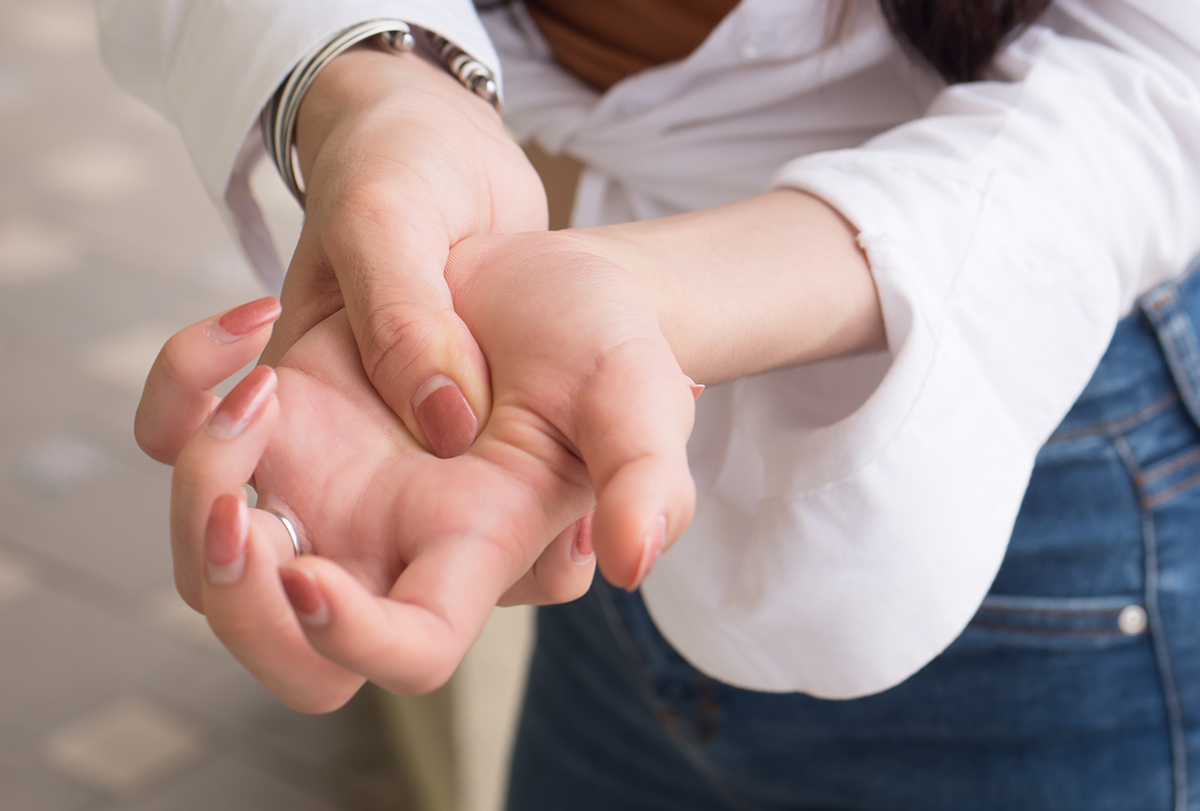
People who frequently use their hand in a repetitive manner are more prone to trigger finger. Also, there is an increased incidence in those with diabetes or rheumatoid arthritis. (2)
General Causes of Trigger Finger
Trigger finger occurs due to an inflammation of the flexor tendon sheath that restricts tendon motion through the pulley system. Repetitive use is oftentimes the common denominator.
Other causes include:
- Repetitive finger movements
- Forceful usage of fingers
- Grasping tightly for long periods
- Gout
Symptoms of Trigger Finger
Symptoms include pain and locking of the affected digit. Stiffness of the finger and contracted joints are also possible in more advanced or chronic cases. The finger will oftentimes snap upon straightening or flexing the digit. (3) Tenderness at the base of the affected digit is common.
Ways to Treat Trigger Finger at Home
The best way to treat a mild case of trigger finger may be just relative rest, heat and/or cold treatments, stretches, and possibly splinting. The use of anti-inflammatories including naturopathic options such as turmeric is also useful.
The most effective treatment is a cortisone shot. About 50% of trigger fingers are cured by a single shot and most will get at least temporary relief. (4)
When all conservative measures have failed, a surgical procedure can be performed under local anesthesia to resolve the condition.
Here’s what you can do if you have trigger finger:
1. Rest the finger

Rest the finger as much as possible until the swelling subsides and it becomes more flexible. Any undue exertion can worsen the damage, so you must give your finger enough time (4–6 weeks) to heal before you start using it for repeated gripping or grasping.
Also, avoid holding vibrating devices with the affected hand for a prolonged period until your symptoms improve. Try not to bend your stiff finger as it can rupture its inner tendon.
If you are forced to do any of these potentially damaging activities, wear padded gloves to give your finger some added shielding and support.
2. Use a splint
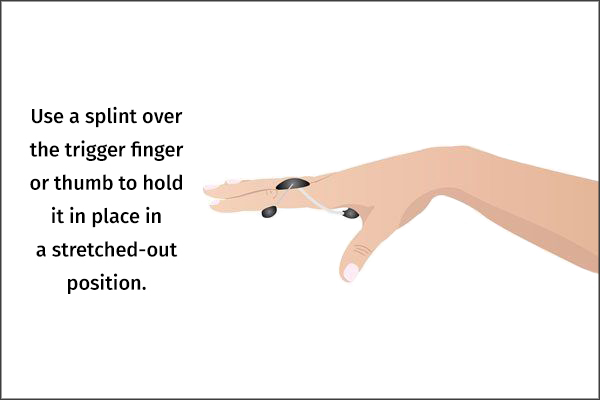
Use a splint over the affected finger or thumb to hold it in place in a stretched-out position. As mentioned earlier, straining, twisting, or bending your stiff finger can worsen the tissue damage and prolong the recovery period.
A splint keeps the finger straight and extended without exerting undue pressure on the underlying tendon, thus giving it plenty of time to heal. Doctors usually recommend wearing a splint for about 6 weeks, particularly while sleeping when you are unaware of your finger placement. (5)
Trigger finger tends to be particularly stiff in the morning, and splint therapy can help avoid that.
3. Apply a cold compress
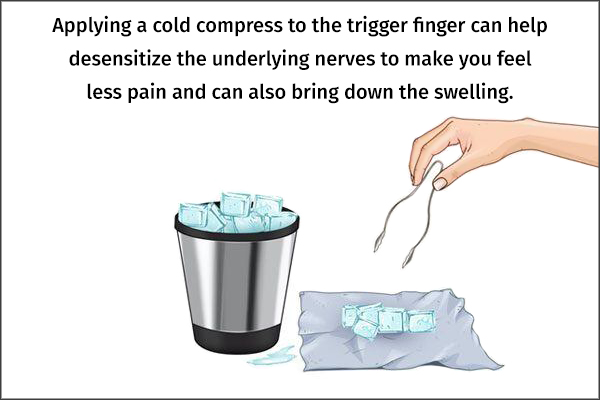
Applying a cold compress to the affected finger can help desensitize the underlying nerves to make you feel less pain and can also bring down the swelling. But both these effects only last for a temporary period.
Cold therapy works by constricting the underlying blood vessels to reduce blood flow in the region. The lack of blood makes the area numb and eases inflammation.
Wrap some ice cubes, an ice pack, or a bag of frozen vegetables in a clean washcloth to make a cold compress at home. Place this compress on the affected finger and palm for no more than 10–15 minutes at a stretch, 33 times throughout the day. (6)
Note that direct or prolonged exposure to freezing temperatures can further damage your tissue and may even lead to frostbite.
4. Soak it in warm water
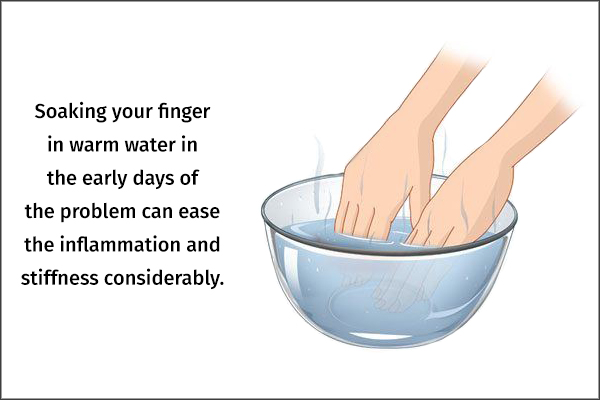
Soaking your finger in warm water in the early days of the problem can ease the inflammation and stiffness considerably.
The warmth seeps into the skin to dilate the underlying blood vessels, thus bringing more blood to the finger. This increased blood flow helps reduce inflammation in the area to make your finger, less stiff and painful. The stiffer the finger, the more likely it is to suffer tissue damage upon movement or exertion.
Adding Epsom salt to the finger soak can further enhance the therapeutic effect on account of its inherent anti-inflammatory properties.
Before immersing your finger in the water, check to see if it’s comfortably warm but not scalding hot. Dip your finger in the warm saline water for 10–15 minutes, three times a day.
5. Try gentle stretching exercises
Doing gentle stretching exercises can ease the stiffness in the finger for better flexibility or mobility. Here’s one simple stretching exercise you can do:
- Place the affected hand on a flat surface with your palm facing downward.
- Lift each finger, one by one, for 1–2 seconds.
- Keeping your fingers and thumb stretched out, join them together and strap a rubber band around them toward the end.
- Extend the fingers gently against the rubber band’s resistance.
6. Gently massage the affected finger
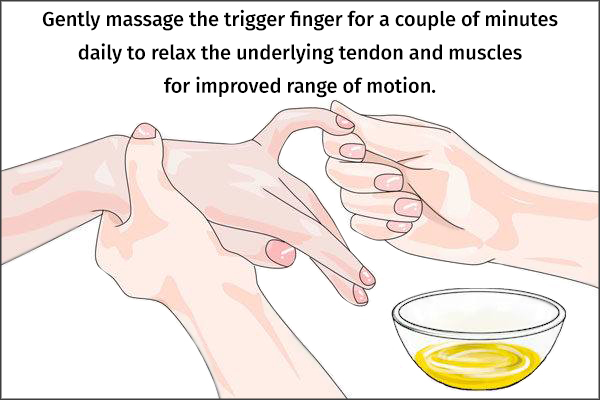
Gently massage the affected finger for a couple of minutes daily to relax the underlying tendon and muscles for improved range of motion. This kind of topical stimulation enhances blood circulation in the targeted area, but best not to use it when the finger is swollen.
Bear in mind that this therapy alone cannot resolve your trigger finger and should be used in conjunction with other treatment modalities.
7. Try turmeric milk
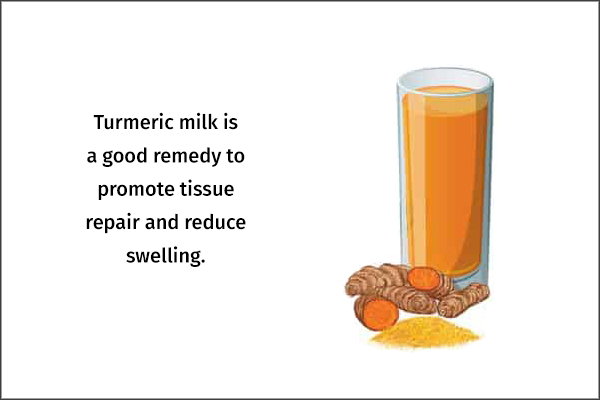
Turmeric milk is a popular remedy to promote tissue repair and reduce swelling. This healing and anti-inflammatory activity can be traced back to curcumin, which is the main bioactive compound found in turmeric. (7)
Curcumin stimulates blood flow to the affected site to curb inflammation. The inflammation needs to subside for the tissue healing to begin.
Try this simple tonic, which has shown promising results without any adverse effects:
- Put 1 teaspoon of turmeric powder into 1½ cup of milk.
- Bring it to a boil and then let it simmer for 5 minutes.
- You can add in a little raw honey to improve the taste, and drink this concoction twice daily.
Complications of Not Treating Trigger Finger
If trigger finger persists, it can result in some limitation in motion of the finger. Flexion contractures sometimes may develop even after surgical release. A certified hand therapist may be required to optimize the return of function and motion to the digit in these more advanced cases.
Most-Asked Questions About Trigger Finger
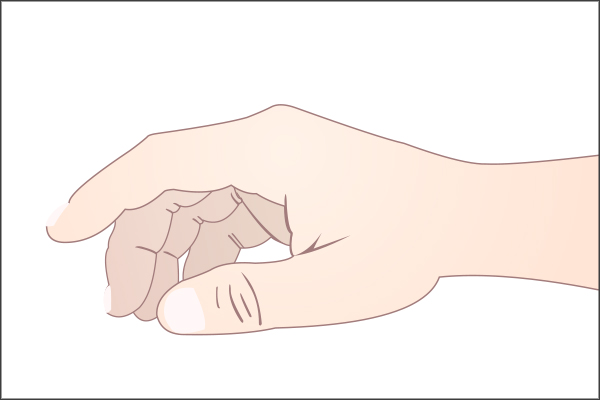
What are the best exercises for trigger finger?
Gentle massage and stretching of the digit may help. Tendon glides are helpful. Look up the “six-pack” hand exercises.
How long does a trigger finger last?
Trigger finger is usually self-limiting, and with conservative care only, it may last for 4–6 weeks. When an injection is given, improvement is often seen within one week. If surgery is performed, it will resolve immediately in most cases.
Why does trigger finger worsen at night?
Trigger finger is often most noticeable during the night or morning hours. During sleep, most people clench their fists, and this can result in a locked digit in the morning hours.
Final Word
Trigger finger is a temporary nuisance and can be treated conservatively in the majority of cases. Fortunately, when conservative measures fail, a quick procedure can be done under local anesthesia that can effectively resolve this condition in most cases.
- Was this article helpful?
- YES, THANKS!NOT REALLY


